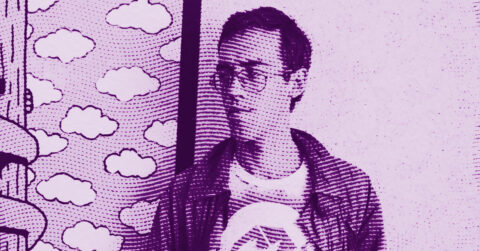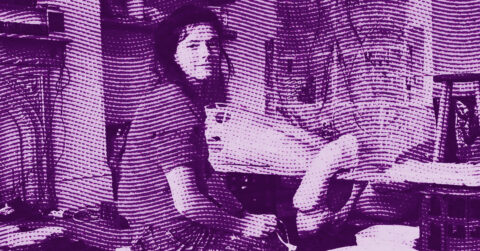Listen to me carefully, you bunch of snobs, there is today an artist whose work probes with a troubling acuity the deepest layers of our collective unconscious. Roby Dwi Antono, born in 1990 in Semarang, Indonesia, has been building for more than a decade a pictorial universe that lies exactly at the confluence between the nostalgia of childhood and the existential anxiety of the contemporary adult. A self-taught man trained in the cultural streets of Yogyakarta, he offers a unique reading of contemporary surrealism that deserves prolonged attention.
The visual universe: between innocence and uncanny strangeness
Antono’s work immediately strikes by its ability to merge seemingly contradictory elements. His canvases feature children with bulging eyes, hybrid creatures half-human half-animal, dinosaurs, spaceships, and icons of popular culture in compositions of remarkable technical precision. These elements are not randomly placed on the canvas; they obey a rigorous internal logic that reveals the intellectual sophistication of their creator.
Antono’s color palette, oscillating between soothing pastel tones and more saturated colors, creates a constant tension between childlike sweetness and deep unease. His characters, often depicted with penetrating and melancholic gazes, seem to bear the weight of premature wisdom. This visual dichotomy constitutes the very heart of his artistic approach.
The artist’s recent stylistic evolution, particularly visible in his “TUK” series (2023) created after the birth of his daughter Laut, testifies to growing artistic maturity. Gradually abandoning the hyperrealism of his beginnings, Antono opts for a freer and more expressive gesture, sometimes using his fingers and palms to paint, thus recovering a spontaneity close to childlike art.
The unconscious at the heart of the work
To fully grasp the scope of Antono’s work, it is necessary to place it in the theoretical context of Freudian psychoanalysis. Sigmund Freud, in his fundamental work “The Interpretation of Dreams” [1], established that “dreams are the royal road to the knowledge of the unconscious.” This statement finds a particular resonance in the pictorial universe of the Indonesian artist.
Antono’s work operates according to the mechanisms that Freud identified in dream work: condensation, displacement, and symbolization. His canvases indeed condense several temporalities and multiple reference universes into a single image. Displacement occurs through the transformation of familiar figures into strange and disturbing creatures. As for symbolization, it runs throughout his work by the recurrent use of elements such as rabbits, dinosaurs, or spaceships, which become so many personal symbols loaded with meaning.
The artist himself acknowledges drawing inspiration from his nocturnal dreams: “Sometimes, I get inspiration from my dreams while I sleep. Even if I don’t remember them well and don’t depict them faithfully, I immediately make a rough sketch of the characters and settings that appear in the dream so as not to forget them.” This creative approach corresponds exactly to the free association process recommended by Freud to access unconscious content.
The hybrid creatures that populate Antono’s universe resemble the compromise formations described by psychoanalysis. These beings, neither entirely human nor completely animal, embody the internal conflicts between our primitive drives and our civilized aspirations. The artist explains: “The animal nature is inherent to humans. I also see animals as creatures that have characteristics and can behave like humans. Both have souls and feelings.”
This psychoanalytic approach to art finds its theoretical justification in Freudian works on sublimation. For Freud, art constitutes a privileged means of transforming repressed drives into socially acceptable creation. Antono’s universe, populated by ambivalent figures oscillating between tenderness and violence, innocence and maturity, is a perfect example of this sublimation process.
The particular relationship the artist has with childhood also becomes clearer from this Freudian perspective. His childlike characters with unsettling gazes evoke Freud’s theory of infantile sexuality and amnesia that affects our early years. These figures seem to carry within them the trace of these archaic experiences we have forgotten but that continue to structure our psyche.
The recent evolution of Antono’s work, marked by his fatherhood, perfectly illustrates the psychoanalytic dynamic of Nachträglichkeit (afterward). The arrival of his daughter allows him to revisit his own childhood with a new perspective, as evidenced by his work on traditional Javanese water sources (“Belik” and “Tuk”), which become metaphors for motherhood and artistic creation.
The construction of mental space
Roby Dwi Antono’s work maintains subtle but profound connections with modernist architecture, particularly with the works of Le Corbusier. This connection, which might seem incongruous at first glance, actually reveals essential correspondences in the conception of space and the relationship between the individual and the collective.
Le Corbusier’s most emblematic project, the Unité d’Habitation in Marseille (1945-1952) [2], shares with Antono’s pictorial universe the same ambition: to radically rethink the organization of space to meet the needs of the modern man. The Franco-Swiss architect conceived his building as a “machine for living in” where every element was designed according to his Modulor system, based on human proportions and the golden ratio.
This systemic approach finds its equivalent in Antono’s compositional method. His canvases adhere to a rigorous underlying geometry where each element is carefully calibrated according to its symbolic and emotional charge. Just as Le Corbusier organized architectural space into “interior streets” linking individual apartments to collective spaces, Antono structures his compositions according to visual paths that guide the viewer’s gaze through the different levels of reading the work.
The Corbusian notion of “vertical city” finds a particular resonance in Antono’s layered universe. His canvases often feature a superposition of planes where different temporalities and different reference universes coexist. This compositional verticality evokes the tiered organization of the Unité d’Habitation, where private spaces, shops, a kindergarten, and sports facilities coexist.
Le Corbusier’s use of raw concrete, which gave rise to the brutalist movement, finds its parallel in the freer gesture adopted by Antono in his recent works. The architect sought in raw concrete a material authenticity that broke with the superficial ornaments of traditional architecture. Similarly, the Indonesian artist gradually abandons the sleek hyperrealism of his beginnings for a more direct and spontaneous expression.
The concept of the “Radiant City” developed by Le Corbusier was based on the idea of a reconciliation between nature and technology, between individual and community. This architectural utopia resonates with Antono’s approach, who seeks to reconcile apparently contradictory elements: childhood and maturity, innocence and experience, humanity and animality.
The relative failure of the large housing estates inspired by Le Corbusier should not overshadow the relevance of his intuitions on the organization of modern space. Likewise, Antono’s sometimes unsettling universes are not merely a matter of aesthetic entertainment but propose a profound reflection on the modalities of contemporary living.
The question of scale, central to Le Corbusier with his Modulor, finds a singular pictorial translation in Antono’s work. His characters, often disproportionate compared to their environment, question our relationship to space and measurement. This deliberate distortion of scales evokes the optical effects sought by the architect in his achievements.
The Unité d’Habitation aimed to be a condensed city, a self-sufficient architectural totality. Antono’s canvases operate on a similar principle: each work constitutes a complete microcosm where all the elements necessary for understanding the artistic intent are present and articulated according to a coherent internal logic.
A visionary self-taught artist
Antono’s self-taught training sheds light on the uniqueness of his approach. Unlike most of his peers from Yogyakarta trained at the Indonesian Art Institute, Antono built his visual culture autonomously, drawing his references from popular culture, science fiction cinema, and mangas. This atypical training allowed him to escape academic conventions and develop a truly personal artistic language.
His initial professional background in graphic design and layout deeply influenced his compositional approach. This experience taught him the importance of visual organization and the hierarchy of information, skills that are evident in the structural sophistication of his canvases.
The evolution of his practice reveals a growing artistic maturity. His early works, marked by a pop surrealist aesthetic close to Mark Ryden or Yoshitomo Nara, gradually give way to a more personal language. The “TUK” series marks a decisive turning point in this evolution, with the artist fully embracing a freer and more expressive gesture.
Antono’s work is part of the broader contemporary Pop Surrealism movement but stands out by its ability to integrate specifically Indonesian cultural elements. His references to Javanese traditions, such as the artisanal wells “Belik”, testify to a local rooting that considerably enriches the universal scope of his message.
The international reception of his work, marked by exhibitions in prestigious galleries such as Almine Rech in London or Anat Ebgi in Los Angeles, confirms the relevance of his artistic approach. This recognition is not a mere fad but testifies to the artist’s ability to address universal issues while maintaining a strong cultural identity.
The contemporary art market, sometimes volatile, has shown sustained interest in Antono’s work, with prices reaching several hundred thousand euros. This economic valorization, while not an aesthetic criterion in itself, nonetheless testifies to the progressive recognition of the quality and originality of his oeuvre.
Limits and questions
The arrival of his daughter Laut in July 2023 marks a major turning point in Antono’s artistic evolution. This experience of fatherhood allowed him to revisit his relationship to childhood from a new perspective, less nostalgic and more constructive. The “TUK” series attests to this profound transformation, with the artist partially abandoning the unsettling universe of his beginnings to explore more peaceful territories.
This stylistic evolution is accompanied by a significant thematic renewal. Water and source metaphors, central to the “TUK” series, reveal a conception of art as a vital resource, as a “source of nourishment and inspiration” according to his own words.
Despite its undeniable qualities, Antono’s work does not escape certain critical questions. The immediate seduction of his images sometimes risks masking the complexity of his message, reducing the reception of his work to a mere aesthetic fascination. This ambiguity between accessibility and depth constitutes a constant challenge for the artist.
Moreover, the recent evolution of his style, marked by a gradual abandonment of the technical precision that made his singularity, raises the question of the coherence of his artistic approach. This stylistic transition, while testifying to an authentic creative search, could also be perceived as a concession to the expectations of the contemporary art market.
Perspectives for the future
At thirty-five, Roby Dwi Antono finds himself at a pivotal moment in his artistic career. The international recognition gained in recent years opens new creative possibilities while imposing new challenges. His ability to renew his plastic language without losing his artistic identity will be the major issue in the coming years.
The gradual broadening of his expressive palette, visible in his recent works, suggests promising developments. His exploration of the relationship between artistic creation and fatherhood opens up rich thematic perspectives that could sustainably nourish his future work.
Roby Dwi Antono’s work reveals an artist at the crossroads of worlds, capable of drawing from the contemporary collective unconscious to produce images of striking psychological accuracy. His art, situated at the intersection of Freudian psychoanalysis and modernist architectural utopia, offers a unique reading of the anxieties and hopes of our time. Neither a simple nostalgic of lost childhood nor a prophet of disenchanted tomorrows, Antono patiently constructs a pictorial universe that transcends traditional dichotomies to achieve a true creative synthesis.
In a contemporary world marked by the fragmentation of experiences and the multiplication of cultural references, Antono’s work paradoxically offers a space for reconciliation. His disturbing yet soothing, unsettling yet reassuring images bear witness to an authentic search for meaning that places this Indonesian male artist among the most relevant voices of his generation. His art reminds us that artistic creation, far from being mere aesthetic entertainment, remains one of the privileged means of exploration and understanding of the contemporary human condition.
- Freud, Sigmund. The Interpretation of Dreams. Paris: Presses Universitaires de France, 1967.
- Le Corbusier. Unité d’Habitation de Marseille. Marseille: Fondation Le Corbusier, 1952.
















